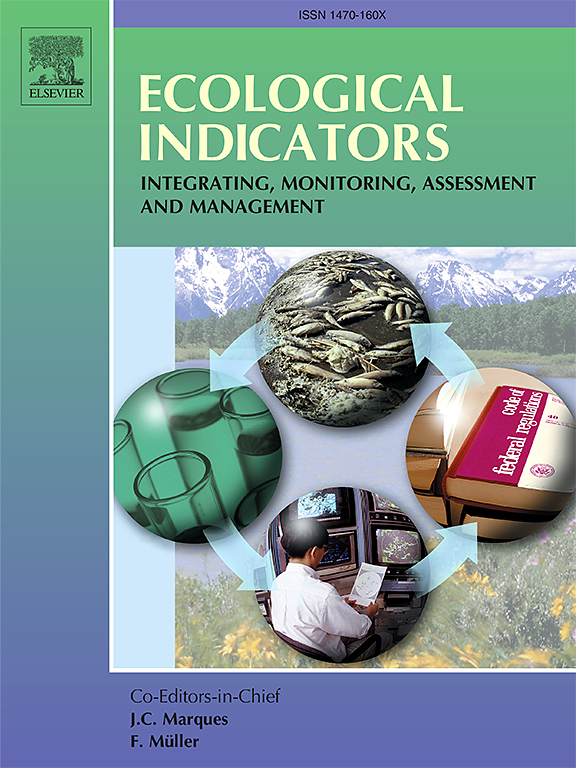Quantifying the impact of urban blue-green spaces on humid-heat exposure risk: A case study of Nanjing’s central urban area
IF 7
2区 环境科学与生态学
Q1 ENVIRONMENTAL SCIENCES
引用次数: 0
Abstract
The accelerating pace of urbanization has markedly increased the risk of humid-heat exposure, posing serious threats to public health and urban ecosystems. Taking the central urban area of Nanjing as a case study, this research employs a downscaling approach based on the Extreme Gradient Boosting machine learning model. By integrating 1 km resolution relative humidity data with 30 m resolution remote sensing data, a high-precision relative humidity dataset at 30 m resolution was constructed. This dataset was further combined with conventional heat exposure assessment methods to develop a novel Population-Weighted Humid Heat Exposure Index (PWHHEI). The spatial distribution patterns between PWHHEI and urban blue-green spaces (UBGS) were analyzed using the bivariate Local Moran’s I statistic, and a Geographically Weighted Random Forest model was applied to assess the regulatory effects of UBGS morphological characteristics on humid-heat exposure and their spatial heterogeneity. The results indicated that high-risk humid-heat exposure areas were mainly concentrated in densely populated urban centers with fragmented UBGS; green spaces played a dominant role in regulating humid-heat exposure, with green area size being the most influential factor, while the regulatory effect of existing blue spaces was relatively limited; and the effectiveness of UBGS was significantly influenced by its spatial configuration, with complex-shaped and clustered green patches enhancing cooling efficiency. This study provides a novel perspective on the dynamics and driving mechanisms of urban UBGS and offers a scientific foundation for its future planning, conservation, and sustainable development.
城市蓝绿空间对湿热暴露风险的量化影响——以南京市中心城区为例
城市化步伐的加快显著增加了暴露在湿热环境中的风险,对公共卫生和城市生态系统构成严重威胁。本研究以南京中心城区为例,采用基于极限梯度增强机器学习模型的降尺度方法。通过将1 km分辨率相对湿度数据与30 m分辨率遥感数据整合,构建了30 m分辨率高精度相对湿度数据集。该数据集进一步与传统的热暴露评估方法相结合,开发了一种新的人口加权湿热暴露指数(PWHHEI)。采用双变量Local Moran’s I统计分析了城市蓝绿空间的空间分布格局,并采用地理加权随机森林模型评估了城市蓝绿空间形态特征对湿热暴露的调控作用及其空间异质性。结果表明:高湿热暴露区主要集中在人口密集的城市中心地带;绿地对湿热暴露的调节作用占主导地位,绿地面积对湿热暴露的影响最大,而现有的蓝色空间对湿热暴露的调节作用相对有限;绿化带的空间形态对其降温效果有显著影响,绿化带形状复杂、聚集性强,可提高降温效率。该研究为研究城市UBGS的动态和驱动机制提供了新的视角,为未来城市UBGS的规划、保护和可持续发展提供了科学依据。
本文章由计算机程序翻译,如有差异,请以英文原文为准。
求助全文
约1分钟内获得全文
求助全文
来源期刊

Ecological Indicators
环境科学-环境科学
CiteScore
11.80
自引率
8.70%
发文量
1163
审稿时长
78 days
期刊介绍:
The ultimate aim of Ecological Indicators is to integrate the monitoring and assessment of ecological and environmental indicators with management practices. The journal provides a forum for the discussion of the applied scientific development and review of traditional indicator approaches as well as for theoretical, modelling and quantitative applications such as index development. Research into the following areas will be published.
• All aspects of ecological and environmental indicators and indices.
• New indicators, and new approaches and methods for indicator development, testing and use.
• Development and modelling of indices, e.g. application of indicator suites across multiple scales and resources.
• Analysis and research of resource, system- and scale-specific indicators.
• Methods for integration of social and other valuation metrics for the production of scientifically rigorous and politically-relevant assessments using indicator-based monitoring and assessment programs.
• How research indicators can be transformed into direct application for management purposes.
• Broader assessment objectives and methods, e.g. biodiversity, biological integrity, and sustainability, through the use of indicators.
• Resource-specific indicators such as landscape, agroecosystems, forests, wetlands, etc.
 求助内容:
求助内容: 应助结果提醒方式:
应助结果提醒方式:


